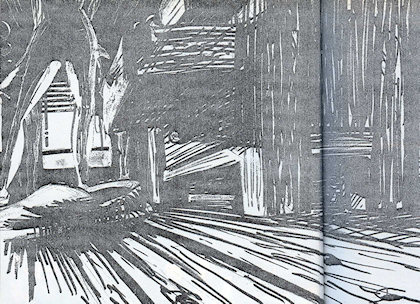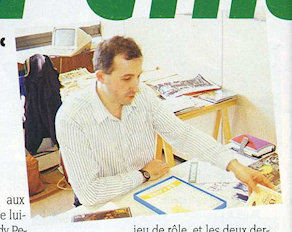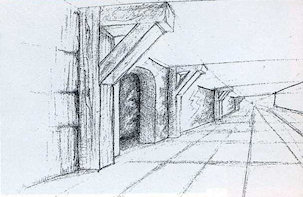Part 1: Epilogue: Call of Cthulhu (part 1)

Not all, but most of the articles we'll be looking at in the epilogues are in French. I have labored to translate these into English using my my grade school French and with the tremendous help of a French-English dictionary. I'll admit they aren't great, but I hope they're readable. My comments are italicized and labeled "Me".
"Call of Cthulhu"
Joystick, May, 1991

This month, Infogrames takes up work on the first game in the Call of Cthulhu series. First episode: choice of topic, design, research... chief of the project is Philippe Agripnidis. He tells the story.

Joystick - Why did you choose the world of Cthulhu?
Philippe Agripnidis - To make it known. That is to say, to also introduce the Lovecraft of the RPG to the public.
Joy - How did you acquire the rights?
PA - Initially, it was Bruno Bonnell (Editor: president of Infogrames) who acquired the rights to use Lovecraft's work from Greg Stafford. Greg, he's a pope of role playing; he has a company called Chaosium, in Oakland, in the United States. The RPG itself was created by Sandy Petersen. In fact, discussions have been going on for two years, but an agreement was reached six months ago.
Joy - Call of Cthulhu will be a series; what does that imply?
PA - There will be five games in total, spread out over five years. The first, the one we are working on right now, will be a mix between an RPG and an adventure game. The second will be an arcade game, the third an RPG, and the last two will be enhanced versions on CD-ROM of the preceding games.
Joy - So, let's talk about the first.
PA - Okay. It's called "In the Dark". In fact, at the start, the project had nothing to do with Call of Cthulhu, it was simply going to be a graphical adventure game. But when we acquired the rights to Cthulhu, we said to ourselves that it might be good to mix the two, or rather, to put the graphical animation principles that we developed at the service of the world of Lovecraft.
Joy - What's the story?
PA - I cannot spoil too much just yet. Let's say it will be a visit to a house. But of course, not an ordinary house... the cinematic cutting of the game is original, if not unique. That is to say, not only is the framing and the shots characteristic of a film, but there will be tight editing: short shots, a second, sometimes. There is literally true staging, so the game is like really living the adventure. That is why we chose 3D.
Joy - Oh, here we go.
PA - Indeed. 3D offers several advantages: first, it saves memory, because instead of storing entire drawings, it only stores the coordinates; and on the other hand, it reinforces the film aspect. And also, it is original to have an entire game environment in 3D. Especially since the routines that we are developing now are particularly fast.

Joy - What stage are you at?
PA - First, we do graphical studies on paper, which allows us to know what will be needed for the animation routines; on the other hand, the script is being finished. We already have a precise enough storyline. Furthermore, the programmer, Frédéric Raynal, who wrote Alpha Waves for the PC and SimCity for the CD-TV, is working on a tool for 3D modeling and animation. Actually, the routines already exist, but he is creating a user-friendly interface that designers can use without wasting time typing coordinates for hours. Everything will be done visually.
Me - 3Desk is the user-friendly utility being referenced here. Part 2 of this article, which we'll be looking at next time, goes into more depth about that.
Joy - How many people are working on this project?
PA - There's a writer, a programmer, and there will be a total of five designers, but alternating. One designer in charge of sketches, another for rough-ins, another for finishing touches... In any case, they cannot all work at the same time. But each has a specialty, an area where they are particularly strong. Here, these are some of Didier Chanfray's preliminary sketches (see photos). They are used to study perspectives. A large part of the atmosphere will be based on a collection of perspectives. We choose the focal length, the height of the camera...
Joy - It is almost an audition for the sets?
PA - Absolutely! As far as it holds the equivalent of cinema sneak previews, that is to say we constructed sequences and showed them to a variety of people - some Japanese, some American, some English, some French of course... - Then they are asked what they saw. If they correctly describe the scene, then the editing and the framing is good. If there are details that they missed, there is something not sufficiently effective somewhere, and we start over. It is important that the program is understood by all, it means that it is universal, of course, but also that the message is strong.
Joy - What extravagant methods!
PA - Of course, the project is very important to us. The story is powerful, the technical performances are brand new, the whole thing is very close to cinema... We also send trial runs frequently to Greg Stafford, who has made some very constructive comments. His opinion is important, since he is a real specialist.
Joy - How does the game take place?
PA - You control a single character. I do not want to spoil too much now, but the player must move very fast to not get the impression of being blocked. And the goal is to not feel that the computer is a barrier, to completely forget the medium and delve into the story.
Me - This is likely a reference to an early idea they had for a gameplay gimmick. The entire house would be dark and the player would only have three matches for light. They would have to complete the game before the matches burned out. Something like this idea is used in Alone in the Dark but obviously not for the whole game.
Joy - Are you meeting the deadline you have set for yourself?
PA - Yes, just about. The music will be done this summer, we will probably use two programmers to go faster, and the game will be ready for release in October.
Me - Franck De Girolami was the additional programmer.
Joy - On which machines?
PA - PC, to start with, followed by ST and Amiga some months later.
Me - Lies. All lies. Besides MS-DOS, versions were released for Macintosh, Acorn Archimedes, NEC PC-98, and FM Towns. Nothing for the Atari ST or Amiga.
Joy - On consoles?
PA - No, but we are developing the CD-ROM version at the same time as the PC version. And there may be a CD-TV version.
Me - The lies continue. It was never released on the Commodore CD-TV, but it was on the 3DO.
Joy - Right. See you in two months?
PA - Okay; by that time, we will be far advanced and we will be able to show some screenshots.
Joy - In two months. Thank you.
